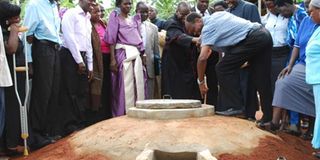Using farm waste for biogas as alternative source of energy

A group of farmers listen as an expert demonstrates how a biogas digester works. FILE PHOTO
Demand for wood fuel for energy use has resulted in trees being cut for wood and charcoal, which has had damaging effects on the environment. Smoke from burning of fuel wood is a hazard to human health and, in addition, the cost of domestic fuel is high.
Therefore, biogas is considered an inexpensive alternative source of energy for cooking and lighting. It is being promoted by different agencies in different parts of the country, especially in the rural areas.
Uganda Domestic Biogas Programme aims to address the gap by developing and disseminating biogas technologies in rural and semi-urban areas.
In this, they highlight the benefits of clean biogas for cooking and lighting and using the bio-slurry, the by-product, to increase agricultural yields.
When any organic matter, such as cow dung, crop residue and chicken wastes, is fermented in the absence of oxygen, biogas is generated.
Biogas contains flammable methane amounting about 60-70 per cent along with carbon dioxide comprising 30-40 per cent, and traces of other gases.
Biogas is colourless and odourless. It is an ideal fuel for a variety of applications such as cooking, lighting and motive power.
The waste from the biogas plant after the gas is produced is an excellent organic manure that improves soil fertility. In addition, biogas offers a number of direct and indirect benefits. For the environment, the trees that would be used as fuel wood can be saved.
Clean energy
There is also improved health arising from avoidance of smoke, which would have been the case with the other forms of cooking. It also saves time, among others.
One of the several initiatives to promote biogas is that being carried out by Agricultural Engineering and Appropriate Technology Research Institute, Namalere (AEATRI).
George Walozi, research officer in charge of energy engineering, AEATRI, explains the programme involves fabricating equipment, which can be used for renewable energy including farm power machinery.
His team is engaged with farmer groups and other communities in Jinja, Mbale, Soroti Kabale, Mbarara, Masindi, Arua, Mpigi and Masaka, among others.
The communities get to know about the energy project through exhibitions, which the team conducts at different events organised by National Agricultural Research Organisation (Naro).
Apart from biogas produced from cow dung, they also sensitise communities about wind energy. AEATRI makes wind pumps to draw water from underground for irrigation of crops as well as for animals to drink.
Fish farmers can also use wind pumps in the fish ponds although that is still at the research stage.
For biomass usage, communities are encouraged to use crop residues as well as animal waste. The objective is to reduce cutting of trees for charcoal, a major source of energy in the country.
A case study was carried out in Kawempe Division in Kampala, where farmers keeping cattle under zero-grazing were trained to make biogas from cow dung. It was funded by France through Makerere University.
George Makumbi, research assistant, AEATRI’s water harvesting and storage programme, explains the Institute came on board for construction of the biogas plants in their homes.
The project focused on urban dwellers to show how waste from zero-grazing cattle can be utilised for biogas. The team ensured the animals must be kept under zero-grazing as one of the conditions.
How to make biogas
When mixing the cow dung with water, the ratio should be one to one. Thereafter, the mix is directed to the digester.
As pressure builds up, which is caused by bacterial action, biogas is produced. This is directed by a pipe constructed from the outlet to where it is needed.
The scientists emphasise that the cow dung used for producing this gas should be “pure”. It can be mixed with urine but no stones or other substances. This may cause yellow flame instead of the blue flame, which is best for cooking. When mixing cow dung with water, use a strainer before it is let into the digester.
The digester is constructed using concrete material but smooth clay is smeared at the outlet, which is kept moist to avoid any cracks.
In case of any leakage, the digester, which is four metres wide, has to be mended. After digesting these materials for the gas to escape through the pipe, the remaining waste is kept in the expansion chamber. It is later used as fertiliser.
‘I invested in biogas’
I am John Sserwada, 65, and I am part of a group of over 20 farmers in Kazo village, Kawempe, who were trained by AEATRI Namalere in biogas produced from cow dung.
I was part of this initiative because I had three cows under zero-grazing, mainly for milk for my family. I also have a farm in Luweero where I grow cassava, banana, beans.
I use fertiliser that I get from the biogas plant that is on the farm. If there is an excess, I sell it to other farmers.
I invested about Shs10m, which I do not regret because I save a lot in terms of charcoal use and firewood.
I used to use five bags of charcoal, which now has reduced to one in a month. I am saving about 80 per cent in terms of purchasing charcoal.
I am not using biogas for lighting yet because I need to purchase the necessary requirements. The beauty of using biogas is that it is environmentally friendly.




